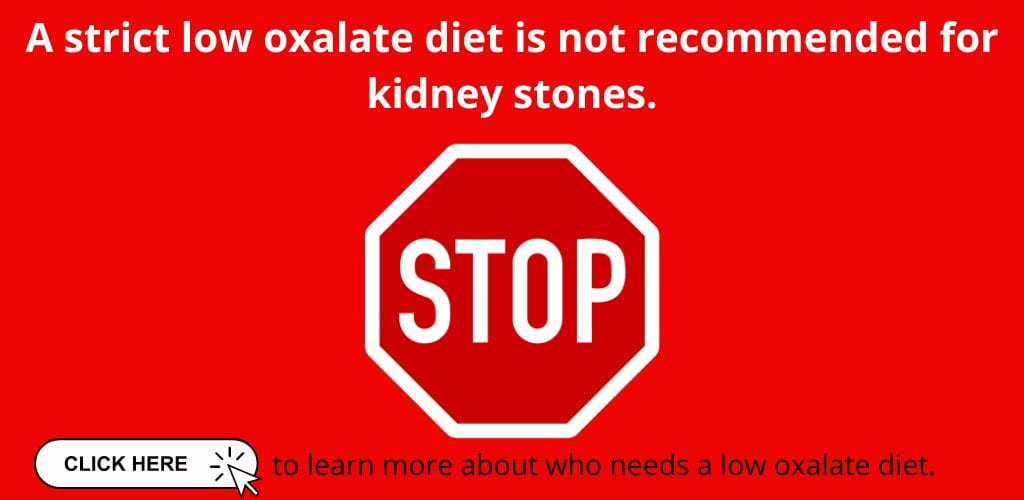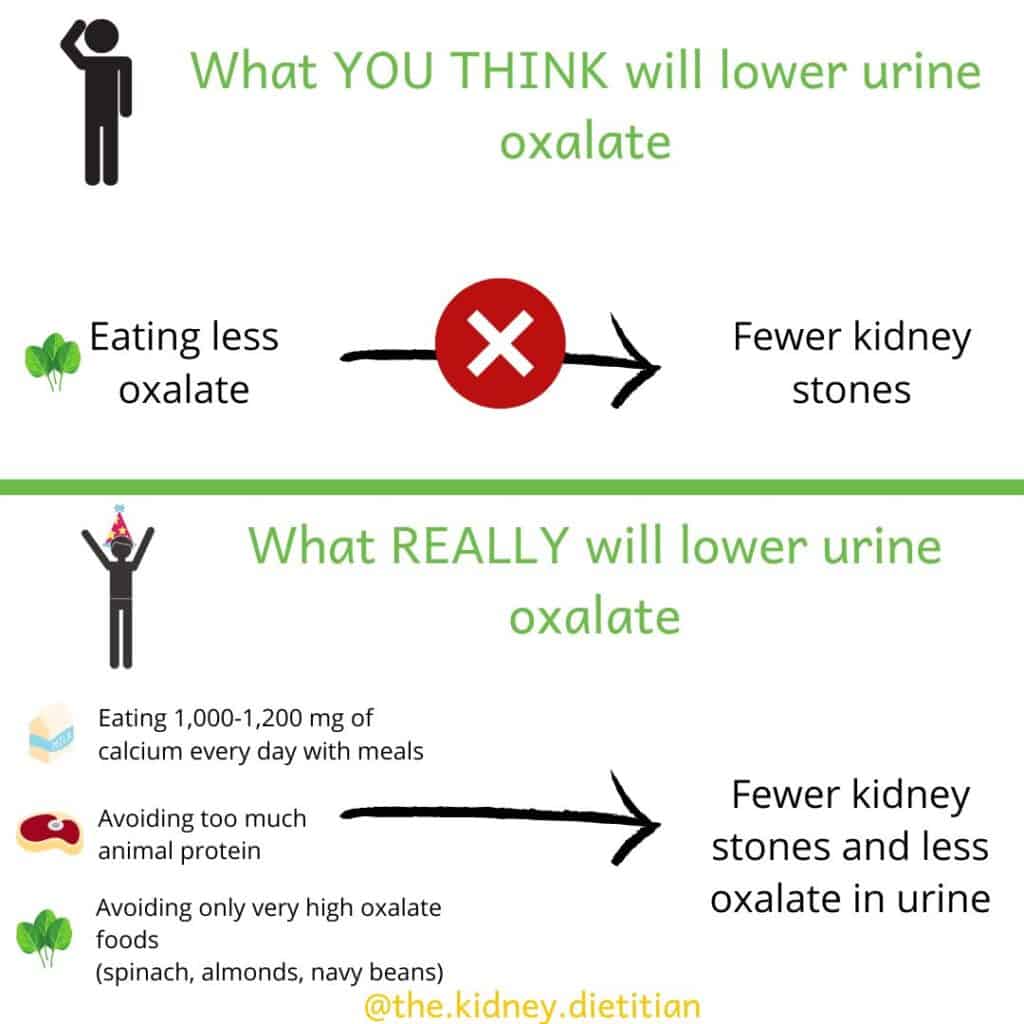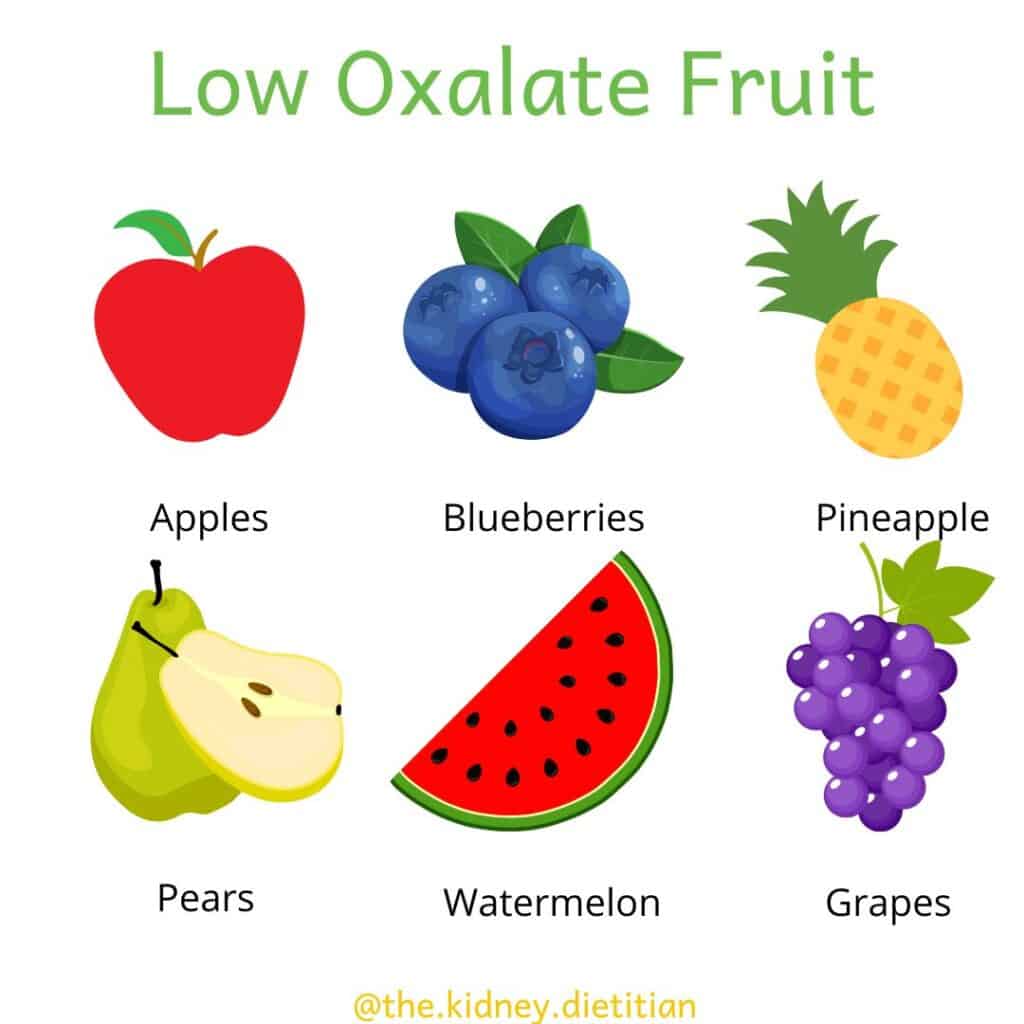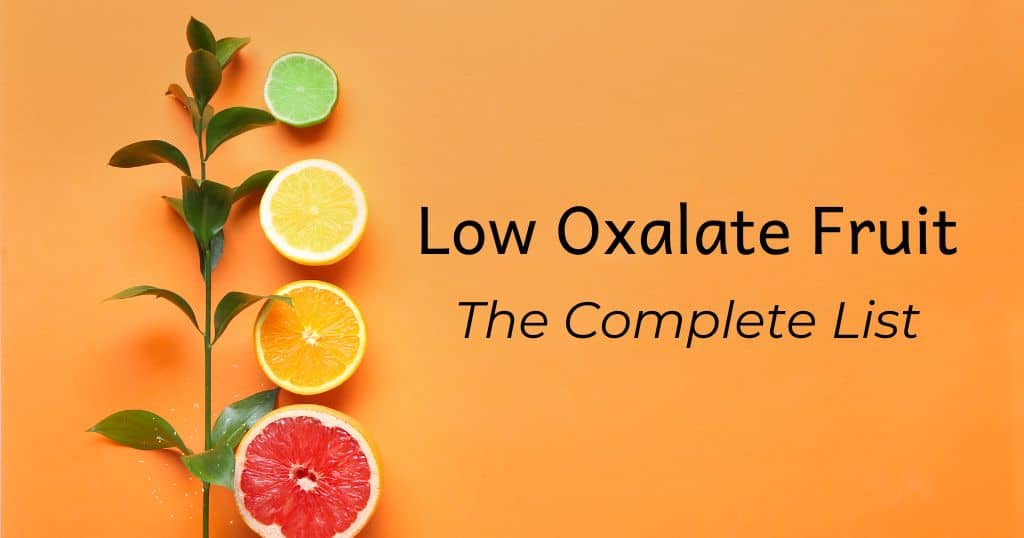Let me guess. You’ve been told to avoid oxalate because you had a kidney stone and now you have NO idea what to eat. I’m here for you!
The feeling that you can’t eat all of your favorite healthy foods, like fruits and vegetables is one of the most frustrating things about a low oxalate diet. As a kidney stone dietitian I promise, you CAN (and SHOULD!) eat fruits and vegetables for kidney stone prevention.
In fact, MOST fruits are low oxalate. Read on to learn more!

Table of Contents
Who Needs Low Oxalate Fruit?
Before we dive into the world of low oxalate fruit, it is important to understand who actually NEEDS low oxalate fruit in the first place.
Hint: Just because you have oxalate kidney stones does NOT mean you need a low oxalate diet! (1)
The key to make sure a low oxalate diet will prevent kidney stones is a 24-hour urine test. This test will tell you and your doctor why your body is making kidney stones. Without it, it is a guess what will actually prevent stones for YOU! Kidney stone nutrition is different for everyone.
If your oxalate is high on a 24-hour urine test, you might need to cut back on how much oxalate you eat. Eating enough calcium is usually a more effective way to lower urine oxalate.
If you do not have high urine oxalate, you do not need a low oxalate diet. A low oxalate diet will likely not prevent kidney stones for you. You don’t need to worry about low oxalate fruit!
If you’ve never had a 24-hour urine test, check out my tips to ask your doctor for the test!
Kidney Stone Nutrition is A Lot More Than Oxalate
Even if you do need a low oxalate diet, chances are there is A LOT more you can do to prevent kidney stones. (2)
In fact, oxalate is the LEAST of my concerns for most of my patients with kidney stones. Yes, even if they have calcium oxalate kidney stones!

Depending on your 24-hour urine test results, there are many possible nutrition changes you could make to stop kidney stones. Here are some of the most common nutrition changes I recommend for kidney stone prevention:
- Drink more water!
- Watch how much sodium you eat. Most people should aim for about 2,300mg of sodium per day.
- Eat more dairy to help make sure you get enough calcium.
- Eat smaller portions of meat, chicken or fish.
- Push the produce! Eating more fruits and vegetables is one of the most effective ways to ward off kidney stones.
Check out my articles about calcium oxalate and uric acid kidney stones for more detailed information.
It is KEY to make sure your diet is personalized to your 24-hour urine test results. Otherwise, your diet changes may not be targeting your body chemistry, and not doing much to prevent kidney stones for YOU.
Check out Kidney Stone Nutrition School to learn more about how I help people create personalized plans to prevent kidney stones!
Why Eat Low Oxalate Fruit?
If you need a low oxalate diet, low oxalate fruit is an important part of your day!
People who eat more fruits and vegetables tend to have fewer kidney stones. (3) (4) (5) Even on a low oxalate diet, it is incredibly important to still get in your fruits and veggies! You just have to choose lower oxalate fruits and vegetables.
As a reminder, if you don’t have high urine oxalate, all fruits can be eaten for kidney stone prevention!
My Favorite Low Oxalate Fruits
Here are my favorite low oxalate fruits. See below for a more complete list of low oxalate fruit!
Grapes
2mg oxalate per cup
A classic. Both red and green grapes are a great low oxalate fruit option.
Enjoy them plain. Or, get fancy and roast them to add to things like flatbreads, oatmeal or salads!
Blueberries
4mg oxalate per cup
Not all berries are high in oxalate. Blueberries are a great low oxalate fruit option. As a Michigan girl, I LOVE blueberries.
Check out this delicious Blueberry Cobbler recipe!
Pineapple
4mg oxalate per cup
What is better than biting into a juicy piece of pineapple? I love snacking on pineapple chunks. Try grilling pineapple slices to jazz up chicken sandwiches, pizza, salads and even an occasional cocktail! Pineapple is also a delicious addition to stir fry.

Pears
2mg oxalate per pear
I think pears may be one of the most underrated fruits out there. Pears are delicious!
Again, eat them raw. Or, roast them to add to sandwiches, salads, oatmeal, toast or flatbreads.
I also love this Maple Pear and Goat Cheese salad. Exciting salads like these are such a wonderful way to up your produce intake for kidney stone prevention. Note: This salad does have pecans on it, but not all nuts are high oxalate!
Melon
0-1mg oxalate per cup
Melon lovers rejoice! All varieties of melon are a great low oxalate fruit choice. Low oxalate melon includes:
- Watermelon
- Cantaloupe
- Honeydew Melon
Try my Watermelon Lime Sorbet as a delicious frozen summer treat!
Apples
1mg oxalate per apple
Yes! All varieties of apples are low oxalate. By themselves, apples are the perfectly portioned portable snack!
You can also bake apples into a tasty apple crumble, chop them into salads or use as a yogurt topping (sprinkled with a little cinnamon!).
I also love these dried apple slices*!
More Low Oxalate Fruit
I could go on and on with all of the delicious low oxalate fruit options out there. Here are some more of my favorites:
- Apricots
- Bananas
- Blackberries
- Cherries
- Cranberries
- Lemons & Limes
- Plantains
- Plums
- Peaches
- Strawberries
High Oxalate Fruit
If you need a low oxalate diet, there are few very high oxalate fruits that you need to limit.
Here are some very high oxalate fruits:
- Raspberries (48mg oxalate per cup)
- Dates (24mg oxalate per date)
- Canned or Dried Pineapple (24mg & 30mg oxalate per 1/2 cup, respectively)
That is it! Truly, all other fruits can fit in a healthy diet for kidney stones.
Ask your dietitian if you need to avoid oxalate and how to enjoy your favorite fruits! If you can’t find a dietitian who specializes in kidney stones, check out Kidney Stone Nutrition School. My favorite part is helping people understand how many healthy and delicious foods they can eat to prevent kidney stones!
Happy Eating!
Melanie


I am interested in taking a maqui berry supplement along with my fish oil. Can you tell me anything about the oxalate levels in maqui berries? Thank you for any information.
I don’t have an accurate oxalate count for that. I’d be wary of most supplements for kidney stone formers though – definitely as your doctor and dietitian what is safe for you!
Hi. I’m new to following a low oxalate diet due to kidney stones. Strawberries were listed on the list my dr have me as a fruit to avoid but I see you have it on your list as a recommendation. Can you clarify? Thanks!
Strawberries are absolutely not high in oxalate. There is a TON of misinformation about oxalate floating around. I also encourage you to check out this article about who needs a low oxalate diet in the first place, and how a strict low oxalate diet can actually make kidney stones worse.
Hi Mrs. Betz,
First of all, I’d like to say that I really appreciate this article because it seems that you present a more accurate picture about foods that are high in oxalates vss. those that are not! As was mentioned in a number of highlighted comments on this site, there is entirely too much conflicting info about this and other subjects pertaining to health and diet. That having been said, I would really like to know if dried black mission figs and cashew nuts are considered high oxalate foods. Also, I have heard it said that drinking milk or a milk substitute that has a moderate amount of calcium content, along with high oxalate foods, allows for the oxalates to bind with the calcium in the gut. Supposedly, when this happens, the oxalates are excreted in the bowel moments as opposed to accumulating and crystalizing in the urine. Is there any truth to this?
Hello. I’m so glad you are enjoying my site. This post about low oxalate nuts will be helpful. And yes – for most people eating enough calcium is key to reducing the risk of stones as it significantly lowers urine oxalate levels. This article goes into more detail. Ultimately, diet changes you make for some prevention MUST be personalized to your 24-hour urine test.
PS Maria again! FYI, I have received the kit for the 24 hour urine test.
HI Melanie! I am so excited to find your webpage. I found out I had kidney stones (I passed them) 1 week ago after being in much pain. I went to research everything I could to understand the stones, I am very heathy senior in my 70s who has followed a vegetarian diet for many years & exercises daily. I was very upset & stressed when I saw the list of high oxalate foods. There was so much contradiction. I eat green leafy veggies & many nuts & seeds. I take the correct vitamin & mineral supplements that I’ve also researched. Now, I find all my healthy foods to be on the oxalate list!! By the statements you made, I already feel better to know someone understands me,
I’m looking forward to taking your online class.
Hi Maria! Thank you so much for taking the time to write this kind comment. It makes my day to hear my site has made you feel better about this whole thing.
Before you go too far down the low oxalate rabbit hole, it is SO important to make sure you even need a low oxalate diet (many people with stones DO NOT). And to know there is SO SO much more to kidney stone prevention than oxalate. I can’t wait to help you figure all of this out in Kidney Stone Nutrition School!
Hi all, I’ve just found out that I need to be on a low oxalate diet with osteopenia..
Apparently high oxalates can prevent the obsorbtion of calcium..
Hi Rita! There is absolutely no data or research to show that a low oxalate diet will help with osteopenia. It is true oxalate binds with calcium in the gut – but our bodies are VERY smart and increase the amount of calcium we absorb from our food based on our needs. We only absorb somewhere between 20-30% of the calcium we eat anyway. There is absolutely no reason to limit oxalate for bone health.
I cannot find any list that addresses currents. I would like to substitute them for high-oxalate raisins. Do you have any information on currents? Thanks.
Both currants and cranberries are a wonderful low oxalate option!
For oxalate data, I use my Cronometer app and select oxalate data sourced from the Nutrition Coordinating Center Food and Nutrient Database (NCCDB). I found:
Pineapple: 165 mg of oxalate per cup
Canned Pineapple: 123 mg per half cup
Dried Pineapple: 80 mg per half cup
Yep! We are going to find completely different numbers from different sources – even from reputable sources. One of the MANY reasons I don’t advocate actually counting oxalate – it will drive you NUTS and likely isn’t worth your time. There are SO many other aspects of nutrition for kidney stones that matter much more!
Thanks for looking this up!
Similarly, cronometer lists both raw blackberries and raw raspberries as having almost the same oxalate per cup (42 and 48, resp.). Annoying!
Yep! There are millions of contradictions out there. One of the MANY reasons why I HIGHLY advise against COUNTING oxalate. It causes SO much (undue!) stress and is, quite frankly, probably impossible to do accurately.
What about Wild Blueberries. I came across a reference that said they were one of the highest?
Nope! Blueberries are actually quite low! No reason to think wild blueberries specifically are higher than conventionally grown berries.
Hi Melanie, could you explain why ( according to this article) fresh pineapple is 4 mg oxylate per cup but canned is 48 mg per cup?
Thanks, Ross.
Hi Ross! Great question. I wish I had a good answer for you. I truly don’t know why there is such a big difference. It makes sense dried fruit would be a little higher since it is concentrated, but not by that much. I suspect the dried pineapple thing is a mistake, but this is the best source we’ve got, so I have to go with it for now!
Thanks for your work!
2 questions: Does cooking spinach reduce the oxalates by much?
and how come pineapple is low in oxalate but high if dried or canned?
You are so welcome! BOILING spinach may reduce the oxalate by about 1/2. BUT, spinach gets so concentrated when it is cooked, it honestly doesn’t matter. Think about 1 spinach leaf raw vs. cooked!
On the pineapple front, I truly don’t know why there is such a big difference. It makes sense dried fruit would be a little higher since it is concentrated, but not by that much. I suspect the dried pineapple thing is a mistake, but this is the best source we’ve got, so I have to go with it for now!
Are pineberries low in oxalates? I think strawberries are fairly high but not sure about pineberries. Thanks
I don’t have an accurate oxalate count for pineberries. However, ALL berries other than raspberries are quite low. You can find my complete oxalate list on my resources page!
I read strawberries are low in oxalates.
Where is the link to the Harvard list of oxalate foods?
Harvard actually recently removed the list from their website. Apparently they plan to update it, and took down the old version. It doesn’t sound like the updated list will be available terribly soon. My list is based off that list- I just standardized the portion sizes for easier comparison! You can find it on my resources page!
Know any particular place where I can find oxalate values for ingredients that are primarily eaten in other cuisines around the world?
examples:
pomelo
fermented tofu
cassava
Unfortunately those foods are not on our trusty Harvard oxalate list -so you would have to search for oxalate values for each of those foods individually. I HIGHLY recommend NOT stressing and spending your time worried about these exact oxalate values (it truly isn’t worth it!). Instead, focus on more of a whole diet approach to stone prevention.
I’ve seen cassava on lists. Always high.
Is organic liquid monk fruit sweetener low oxilate?
I don’t have an accurate oxalate measurement for that.
monk fruit sweetener seems to be much better for me with oxidates than stevia. I’m having no issues with Monk fruit
I’m sure you appreciate the confusion we kidney stoners face when researching foods low in oxalates. Your website and Harvard medical list blueberries and blackberries are low in oxalates, here’s my urologist office state they are high in oxalates and should be avoided. I find conflicting recommendations for seeds & nuts as well as many other foods. I get to the point where I think I’ll just do my best and deal with the stones that occur every other year.
I absolutely do! There is a TON of misinformation out there when it comes to oxalate – even from highly reputable sources. I recommend sticking with ONE list so you don’t drive yourself crazy. I use that Harvard list as we know it was generated from accurate testing methods. Also, I always like to point out that oxalate is usually the LEAST of my concerns for stone prevention!
I have had kidney stones 3x in 2 years, years ago. Worst pain I think I have ever experienced. Haven’t had any in over 7 years. Don’t drink tea. That was my biggest culprit I believe. Also 2 oz of lemon juice mixed with 2 oz of olive oil. Drink that mixture then a glass of water. During an active stone drink in the morning, afternoon and evening. For preventative maintenance 1x a week. I also drink lemon water first thing in the morning every morning. Hope this can help you!
Thanks for sharing your experience, Shawna! I actually have some info on olive oil and lemon juice for stones. It is so important to remember that stones are completely different for each person. Nutrition for stones MUST be personalized to your 24-hour urine test results to be effective.
I am so glad that I found this site. My husband is having kidney stone surgery today…. 2nd surgery 2 WEEKS! We are desperate to find a solution. We were told by a lady in the waiting room a few weeks ago (she was a driver for a patient) that she started drinking pure no sugar added cranberry juice and had not produced any since. We were just given some fresh made juice and my husband was planning on start a shot of the juice every morning and night…Good or bad idea in your thoughts? He is seriously desperate his body produces non stop.
I’m so glad you found me as well! Cranberry juice is actually associated with a higher risk of stones – so bad idea. Kidney stone nutrition is different for every single person – a 24 hour urine test is key to understanding what YOU can do to prevent more stones. I’d recommend checking out my podcast too, in addition to this website. I help people figure all of this out in my courses as well.
i have had kidney stones for over 22 years. I can only drink water. I have found out that dark sodas, tea, salty foods will cause that. but to break them up is plain Alka Seltzer. I actually learned that from my nephrologist two years ago. the citric acid breaks down the stones and makes them smaller. but the more water to drink the better. 😁 hope everything works out!
Hi Janette – this is only true for uric acid kidney stones. It is SO important to remember that kidney stone nutrition is different for every single person, based on their 24-hour urine test results!
There’s a photo of rhubarb above but it’s not included in the list of high oxalate fruits. Rhubarb is very high! According to healthline.com, 570-1900mg per 100g… with the leaves containing more than the stalks.
This list is not meant to be a comprehensive list of high or low oxalate foods. You can find a more complete list on my resources page!
As a diabetic, It has been very interesting and hard to learn what to eat., for kidney stones as well. I am hoping after my next 24 urine tests can relax about how much low oxalate I will need to eat. I hope with low salt and more water with address some of the issues As a diabetic I was trying to eat more protein and fewer carbs. The kidney stone diet has reduced the amount of protein, I have been trying to have more cheese, eggs, and beans. I do have some ground turkey waiting for me of the next few days.
It can be challenging to combine recommendations for multiple conditions! Luckily changes for diabetes and stones are really MUCH more alike than you might think! Let me know if you ever want my help!
Are raisins with oatmeal good to eat?
Raisins can be a great way to add some extra fiber and some sweetness to oatmeal! I can’t say what is best for YOU. Ask your dietitian who is familiar with your medical history, current eating habits and labs!
it’s hard for me. I just moved to chronic kidney disease stage 3. I have RTA, and I keep kidney stones. my nephrologist just told me not to eat anything with calcium oxalate. not to mention I have a milk allergy, and my urologist has me on a strict diet of no beef, pork, citric fruit and anything with citric acid in it. so I’m very limited. I can’t have any seasonings on my food, because it hurts my RTA, and end up with bladder spasms for days. so, any suggestions on what to eat?
Hi Janette! I’m so sorry you are feeling so defeated. It sounds like your doctor is giving you some dangerously outdated and non-specific advice for your situation. I’d HIGHLY recommend working with a dietitian that specializes in kidney stone prevention to help you put all of this together. I PROMISE it doesn’t have to be as hard as it feels right now. There truly are more foods than you can eat than not!
I love figs, particularly dried figs steeped in white tea to make them extra soft, juicy and comfortingly warm. The Harvard list says 5 dried figs have 24 mg oxalate. Thankfully, I suppose that’s still on the low side.
Yum! That sounds delicious! It is also so important that “low” and “high” oxalate foods are very subjective. There is no definition or cutoff of what defines a “low” oxalate food. This is actually good, as everyone has different oxalate needs. It sounds like you’ve made a way to make your beloved figs work for you!